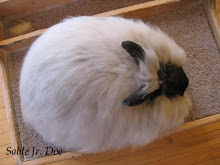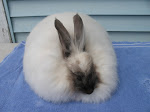I have been insanely, ridiculously busy the last two weeks, and this explains why I have been so delinquent in blog posting. LOL. Baseball and all the other organized activities have ended at this point, so now I am cleaning my house and trying to get organized with home stuff, summer (kid) stuff, and bunny stuff:).
Looking at baby production so far this year I think that I have probably bred more litters in 2010 than ever before (according to records up to July). The oldest bunches born in April have pretty much all been dispersed by now, and the next batches begin weaning tomorrow, after which 5 more litters will move to the barn with mom to grow out.
It has been extremely hot here this summer, and it has been one heck of a job trying to keep everybun cool while allowing show coats to grow in for fall at the same time. Attached below is a post from my old blog about keeping rabbits cool. Hope everyone is hanging in there and not suffering any major losses!
Summertime Angoras
Here are a few tips for keeping Angoras cool in summer:
1) Try not to time your breedings so that your bunnies are in extreme full coat during the heat of the summer. If you are a spinner and keep bunnies for wool this should be simple to do if you record the average holding time of your coats and breed your babies to molt before the warm weather comes. If you are a Show breeder you can do precisely the same thing if you live in an area where there are no shows at that time of year, otherwise you will have to investigate methods of keeping them cool or keep several indoor cages for buns in the heaviest coats.
2) Make sure there are fans in your rabbitry, and be sure that those fans are taken apart and cleaned before the start of the season, and periodically throughout the summertime to avoid fire hazards. Position fans on either end of the rabbitry between the aisles or suspend them from the ceiling in various positions so that the draft hits no one directly. A thermometer placed on the wall is also helpful, and the fans can be turned on whenever the temps. go above 80 or it is excessively humid.
3) Place ice bottles in your freezer weeks ahead of time to have on hand for the very hottest days. Buy or find 2 liter soda bottles and freeze them halfway to 3/4 full with water and place them into the cages when it gets very warm. Since soda bottles are large they will stay frozen for up to 2 hours on a hot day, and the rabbits cannot get a grip on the tubular shape to chew the plastic.
4) Keep cage pans and cages in general cleaner than usual in the summer. Urine and the ammonia it produces create heat, and if there are 50 rabbits in a building with full pans (assuming you use cages with pans), the temperature is naturally going to increase, sometimes dramatically. Also, cleaning cages more often keeps the flies down, which lessens the chance of flystrike.
5) Try to construct your rabbitry in a shady area, and if there is no shade plant some vines or fast growing shrubs or trees that will shield the structure and lower the temperature in the building somewhat. (Note: Be certain that nothing planted over the barn is poisonous!)
6) Refill water bottles with ice cold water once or twice a day and add Acid Pak on the very warmest days to keep electrolyte levels on an even keel. Also, scale down the amount of pellets you feed since rabbits do not need to create heat in the summer. In the Spring and Fall a mounded cup of Pellets for adults is appropriate for an FA, in summer it is a good idea to remove or minimize all top dressings and "hot" grains, and feed 1 level cup of pellets to each adult rabbit per day.
7) Another way to keep bunnies cool is to go into the building periodically with a wet cloth or spritz bottle to wet down the ears of your bunnies. Rabbits regulate heat through their ears, so cooling them down this way will enable them to find relief immediately. Be sure not to drip water into the ear canal, and if the rabbit in question is in coat be certain not to drip water onto the wool around the ears to avoid matting.
8) If you are breeding or have nursing does in the barn pay special attention to their comfort since they will suffer far more in the heat than bucks, young rabbits, and non-pregnant does. A late-term pregnant doe is in greater danger than a nursing doe, but both will feel the heat and have a much more difficult time than others in the barn. Also, bucks tend to be affected by heat more easily than does, (and can go sterile if the temps rise above 85 for 2-3 days in a row). The entire herd is much more susceptible to heatstroke during the first 1-2 heat waves of the year before slowly acclimating to the higher temperatures. All rabbits seem to tolerate the heat better late in the summer once they have become accustomed to it.
9) It is questionable whether it is a good idea to immerse an Angora in extreme heat stress in water. Breeders of short haired rabbits routinely use this technique, but an Angora coat complicates that approach, so unless the rabbit has been sheared down to the skin (in which case heat stroke would be unlikely), the wool will matt up to the point where it will be next to impossible to get it off, even with a scissor. It is also important to note that the skin of a matted rabbit cannot breathe and heatstroke may become imminent. Angoras should be well groomed or clipped altogether in the summer to assure proper air circulation. If a rabbit is in serious danger, bring it indoors to an air conditioned room OR to a basement or garage to lay out on the concrete floor. Soak the rabbit's ears down repeatedly with cool water, and keep it calm and quiet. Once it has recovered sufficiently, keep the animal indoors until evening with herbs such as Dandelion or Parsley, and make certain that Acid Pak has been added to cool water to give the bunny's system a boost and help it recover.
10) Another option is to hang bags of ice cubes over the fronts of your fans to blow cold air into your barn ( similar to a homemade air-conditioner). Just make sure that the bags do not leak and are not situated anywhere where they can be sucked into the fan blades.
These are a few warm weather tips, but generally speaking if angoras are sheared every summer and have adequate housing and ventilation, they are excellent at surviving and thriving. Keep a close eye on your rabbits at all times and know their habits so that stress can be identified quickly. As with everything, good management is the key to keeping Angoras healthy in summertime:).
Sunday, July 18, 2010
Subscribe to:
Post Comments (Atom)























4 comments:
KEEP YOUR ANGORA BUNNIES COOL in warm and Humid Weather or they DIE
Dear Angora Rabbit Lovers,....
My beautiful male Angora Rabbit of 2 years, who waited up for me each nite, ready for me to pick him up form his outdoor cage, hold him and then take him to another indoor cage for the night, DIED suddenly yesterday afternoon. I am devastated. I took care of him,....and he brought sooooo much joy to our family - but Angi Pangi and I bonded the most. Had i had all this information about using FANS and MISTS and FROZEN WATER BOTTLES; my little fellah would still be alive today!
When I got him, he was about a year and I googled for Angora Bunny info - but nothing I read then emphasized about HEAT being a DEADLY KILLER for your so treasured and cherished bunny.
I am hurting because,I miss him,.. He would rattle in his cage when he wanted more food or to have me pick him up,.....On many a stressful day, I would hold him for 1/2 an hour on my lap and he "just was" and absorbed my joy and pain. I feel responsible for those in my family as well as the under dog, and this little fellah shouldn't have been outside in the 30 degrees hot humidity. I didn't realize he needed my help, as he was outside last year, and all was ok. I never place his cage in direct sunlite, but rather in the shade with food and his water bottle. He didn't have to die this way,....I/m not certain it was the hot weather,...but probably.
Our ignorance,...but nothing can bring him back.
mold and mycotoxin poisoning was the cause of death my rabbits.
I left the bags of food on the porch, through rain, humidity,...
Now i know better
Hello, I am a new rabbit raiser since 2017 with a small family of 7 german angoras. This summer we are regularly having 85-95 degree days and I am constantly worried about the rabbits. We sheared them down to 1.5mm and their hutch is in the shadiest part of the yard, but they still seem to really suffer and I am always scared that we'll lose one. I've tried keeping them into our downstairs, but as you know, rabbit urine is very pungent and my dear husband begins to complain after just two days. I have cement tiles that I can put in their run, but no access to fans. Can you recommend anything else?
Post a Comment